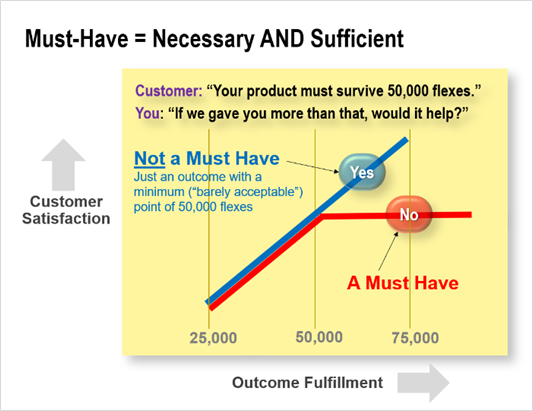An outcome cannot be both a MH and a TP. Here's why.
As we’ll explain in a moment, it’s important that you don’t confuse MHs and TPs. At the end of the interview, all your notes will either be unmarked, marked TP, or marked MH. An outcome cannot be both a MH and a TP. Let’s see why:
Our definition of a Must Have is this: The outcome is both necessary and sufficient. In other words, the customer must have this outcome or they cannot use your product (it’s necessary). But—and this is important—they will not benefit if you provide more of this outcome (it’s sufficient).
Here’s an example: The customer says your product must survive 50,000 flexes without failing. Is it a Must Have? At this point we don’t know. We need to ask a critical question:
“If we gave you more, would it help?”

If the customer says, “Yes, we’d love to see 60,00 or 70,000 flexes,” it’s not a Must Have. Because 50,000 flexes wasn’t sufficient. Rather it’s an ordinary outcome with a minimum acceptable value. Later—in Preference interviews—you’ll ask the customer what this “barely acceptable” point is. If on the other hand, the customer says, “No, it wouldn’t help… we just need 50,000 flexes,” then it is truly a Must Have.
This leads to practice you should adopt that few B2B professionals have: Whenever someone shows you a specification sheet, you should go through each item and ask, "If we gave you more on this, would it help?" Purchasing agents seldom know the answer to this question... although they'd like to say "no it wouldn't help" for each specification. That way they could call your product a "commodity" and just focus on their specialty... price. You need to speak to contacts at your customer who do know these answers, as this can give you an advantage over competitors who don't know what should and should not be improved.
Why is it important to not confuse MHs and TPs? Consider two cases:
- You mislabeled a MH as a TP: In Preference interviews you’ll only have time to ask customers about ten outcomes, and you don’t want to “use up” one of these precious ten slots to questions you already have the answers to. For instance, let’s say a Must Have was “Must meet current fire codes.” When you ask the customer how important this is, you know they’re going to say meeting fire codes is a “10” (critical). And when you ask them how satisfied they are today, they’re going to say “10” (totally satisfied). They’re certainly not going to tell you they are now breaking fire codes, right?
- You mislabeled a TP as a MH: What if your customers don’t understand what a Must Have is… and they take it to simply mean an outcome they really want to see? You may not want to debate them during the interview, but be sure to re-label this as a TP later. Otherwise, it won’t show up in Preference interviews where you can capture 1-to-10 ratings—and you won’t learn more about how you can improve this outcome.
For more on Must Haves, see e-Learning Module: Discovery Interviews at www.blueprintingcenter.com > e-Learning.
Keywords: must have, must-have, MH, top pick, TP, required, table-stakes, price-of-entry, necessary and sufficient, mislabel MH, mislabel TP
